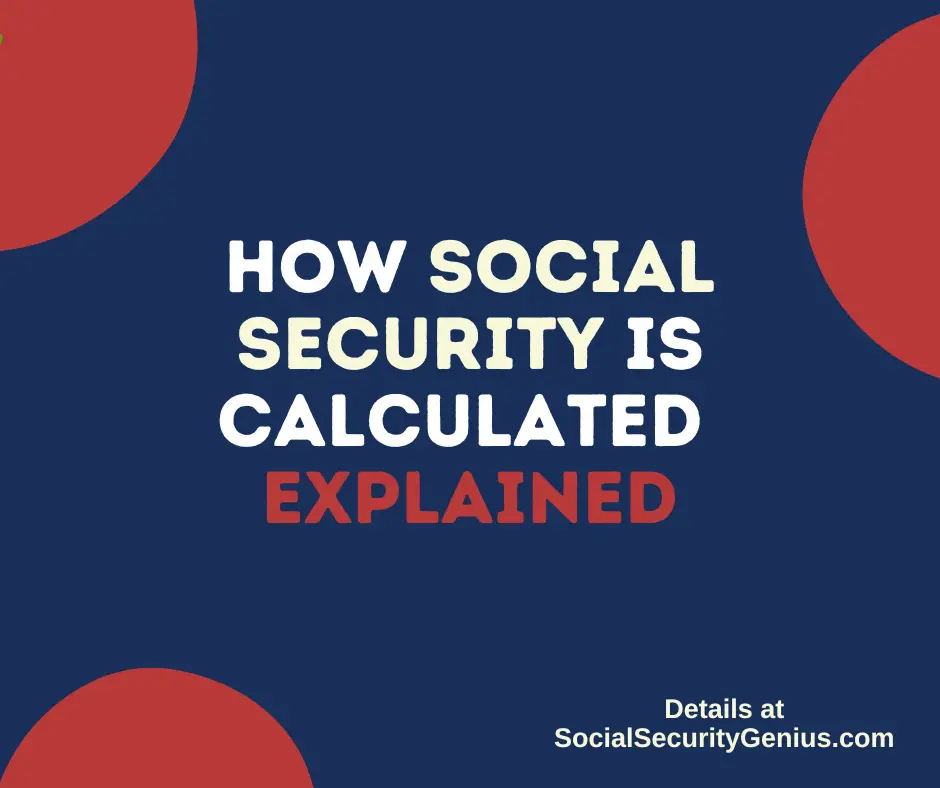One of the most frequently asked questions by would-be retirees is How Social Security is Calculated. This post will provide an answer to the question.
Additionally, we will answer the most frequently asked questions about how Social Security benefits are calculated including:
- How Is Social Security calculated for married couples?
- What is the minimum Social Security benefit with 40 credits?

How Social Security is Calculated
To calculate your benefit amount, Social Security looks at your entire work record. Here is how the Social Security benefits formula works:
First, every year’s earnings are indexed for inflation, and then the 35 highest are considered when calculating your benefit.
If you don’t have 35 years of earnings, zeros will be used for the remaining years.
Second, The 35 highest inflation-adjusted years are added together and averaged, to arrive at your lifetime average Social Security earnings.
This amount is divided by 12 to determine your Average Indexed Monthly Earnings (AIME).
Third, once your monthly average is determined, it is applied to this formula to determine your Primary Insurance Amount (PIA).
The PIA is the benefit a person would receive if he/she elects to begin receiving retirement benefits at his/her full retirement age.
At this age, the benefit is neither reduced for early retirement nor increased for delayed retirement.
The formula used to compute the PIA reflects changes in general wage levels, as measured by the national average wage index.
The Social Security Administration releases a table each year showing the dollar amounts that go into the PIA formula (called bend points).
PIA formula
Here is the PIA formula for benefit calculation for workers retiring in 2023 based on the 2023 bend points table:
- 90% of the first $1,115
- 32% of the amount above $1,115, but less than or equal to $6,721
- 15% of the amount over $6,721
The sum of those three figures is your PIA, also known as your “full retirement benefit.”
For example, assuming that a person, Jane Doe, is first eligible for Social Security in 2023 and retires in 2023, and will start collecting benefits in 2023.
If she turns 62 in 2023 but decides not to start collecting benefits till say age 67 in 2028, the 2023 formula will still be used to calculate her benefit.
Once her benefit is calculated, the Social Security Administration will add Cost of Living Adjustment increases (COLA) to her benefits until she starts collecting benefits, up to age 70.
However, any earnings between now and when she starts collecting benefits can be factored into determining her AIME, so her benefits may go up.
What if you are low-income and did not earn a lot of income?
For most people, Social Security benefits are calculated based on lifetime earnings.
In order to be eligible for Social Security retirement benefits, you’ll need to earn a total of 40 “credits” over the course of your working lifetime.
If you do not earn a lot of income during your working years, you may be eligible for the Special minimum payment.
The special minimum Social Security benefit is a minimum PIA that was created in 1972 to provide benefits to certain low-income workers.
Specifically, the special minimum benefit is designed for people who have lower lifetime earnings overall.
These benefits are calculated based on years of service, not earnings.
The goal is to offer a higher number to certain low-income participants than the traditional benefit formula would produce, resulting in bigger monthly checks.
Low-income workers must have at least 11 years of coverage to qualify.
FAQs about How Social Security is Calculated
Here are the most frequently asked questions about how Social Security Benefits are calculated:
How Much do you need to make to earn one Social Security Credit?
Most people need 40 credits to qualify for Social Security retirement benefits. Workers can earn up to four credits per year.
In 2023, the amount needed to earn one credit is $1,640.
You can work all year to earn four credits ($6,560).
Additionally, you can choose to earn enough for all four in a much shorter length
of time.
Also, if you earn four credits a year, then you will earn 40 credits after 10 years of work.
At What Age Can You Start To Receive Social Security Benefits?
The age you begin receiving your retirement benefit affects how much you will receive in monthly Social Security benefits.
There are three factors about when you retire that affect the benefits you receive:
Full Retirement Age
Full retirement age, or FRA, is the age when you are entitled to 100 percent of your Social Security benefits.
Depending on the year you were more, your Social Security full retirement age is between age 65 and 67.
Claiming Social Security benefits before the full retirement age will lower your monthly payments.
You can increase your retirement benefits by waiting past your FRA to retire.
Early Retirement Age
You can start receiving your Social Security retirement benefits as early as age 62.
However, your benefit amount will be cut. That’s because you are collecting benefits earlier than your full retirement age (FRA).
Delayed Retirement Age
When you delay benefits beyond your full retirement age, the amount of your retirement benefit will continue to increase up until age 70.
There is no incentive to delay claiming your Social Security benefits after age 70.
What is the minimum Social Security benefit with 40 credits?
The average Social Security amount in 2022 was $1,701.62.
The table below shows the average benefit for Social Security beneficiaries in 2023.
| Type of beneficiary | Percent of total payouts | Average monthly benefit |
|---|---|---|
| All recipients | 100% | $1,701.62 |
| Retirement benefits | 78.2% | $1,788.89 |
| Retired workers | 74.2% | $1,837.29 |
| Survivor benefits | 8.8% | $1,451.85 |
| Nondisabled widow(er)s | 5.3% | $1,713.36 |
| Disability insurance | 13.1% | $1,347.18 |
| Disabled workers | 11.3% | $1,486.42 |
However, some low-income earners do not earn enough money to make the 40 credit minimum.
For this reason, the special minimum primary insurance amount (PIA) was enacted in 1972 to provide adequate Social Security benefits to long-term low earners.
The first full special minimum PIA in 1973 was $170 per month.
However, because of cost of living adjustments, the minimum amount has increased to $886 per month in 2020.
How Is Social Security calculated for married couples?
If your spouse has filed for Social Security benefits, you can also collect benefits based on the spouse’s work record.
However, you have to meet the following criteria:
- You must be are at least 62 years old.
- Regardless of your age, if you care for a child who is entitled to receive benefits on your spouse’s record, and who is under age 16 or disabled.
The spousal benefit is calculated as the greater of the individual’s own worker benefit at Full Retirement Age, or one-half of the spouse’s worker benefit at Full Retirement Age.
You may be eligible for Spousal Social Security benefit if you’re married, formerly married, divorced, or widowed.
While you can collect spousal benefits as early as age 62, the amount of the benefits you will receive will be reduced since you are collecting benefits before your full retirement age.
How much Social Security will I get if I only worked 10 years?
You need at least 10 years of work (40 credits) to qualify for Social Security retirement
benefits.
The Social Security Administration will calculate how much you will get in benefits based on your highest 35 years of earnings.
However, If you do not have 35 years of earnings by the time you apply for Social Security, your benefit amount will be lower than it would be if you worked 35 years.
In an example provided by AARP, a single person born in 1960 who has averaged a $50,000 salary, would get $1,349 a month by retiring at 62.
However, the same person would get $1,927 by waiting until age 67, the full retirement age.
Furthermore, he or she would get $2,389, the maximum benefit on those earnings, by waiting until age 70.
As mentioned earlier above, Social Security benefits do not increase if you wait to collect past age 70.
How Social Security is Calculated Summary
Here’s the bottom line about how Social Security is Calculated:
Every year’s earnings are indexed for inflation, and then the 35 highest are considered when calculating your benefit.
Next, the 35 highest inflation-adjusted years are added together and averaged, to arrive at your lifetime average Social Security earnings.
This amount is divided by 12 to determine your Average Indexed Monthly Earnings (AIME).
Lastly, once your monthly average is determined, it is applied to this formula to determine your Primary Insurance Amount (PIA).
Questions?
We hope this post on how Social Security is calculated was helpful.
If you still have questions, you should leave a comment below.
However, what may be an even greater help is to join our FREE Facebook members group about Making Sense of Social Security Benefits.
It’s a very active group with some really smart people who love to answer any questions you may have about Social Security Benefits.
Also, from time to time, our team of editors drop in to contribute and answer questions.
Finally, be sure to check out our other articles about Social Security and Disability Benefits, including:


